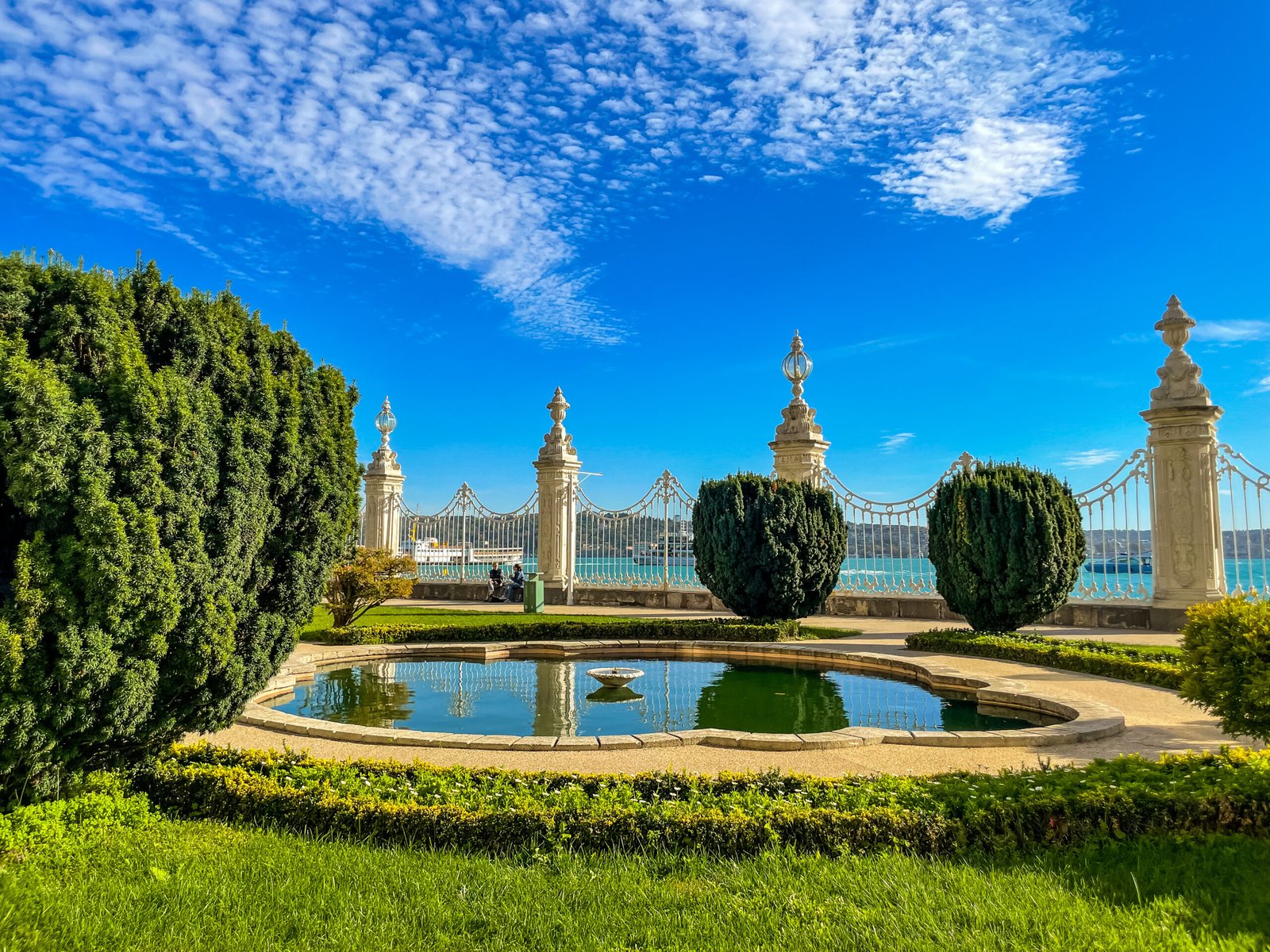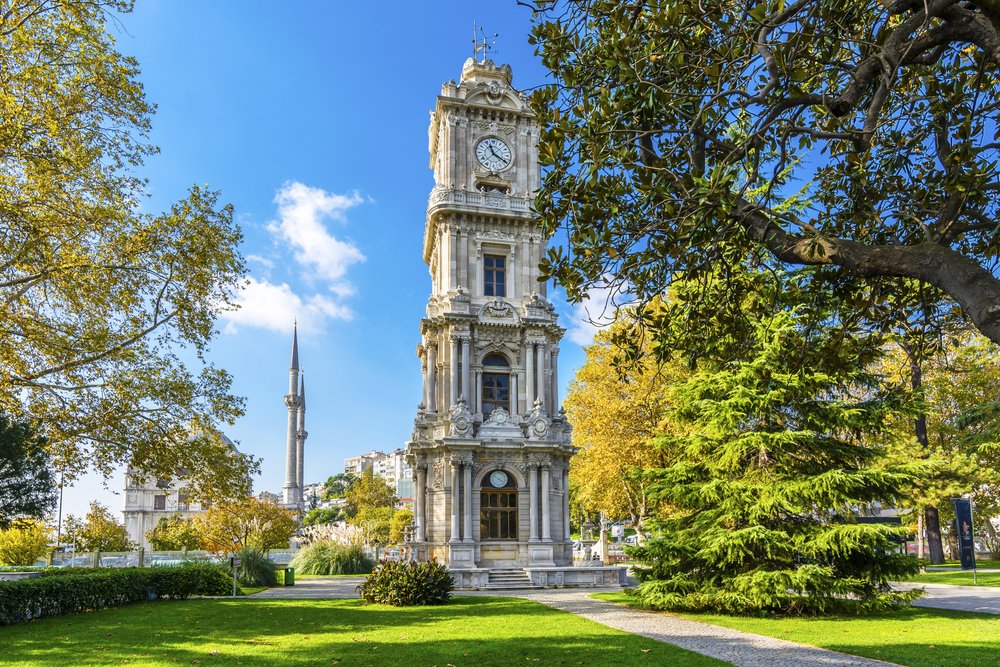LEARN MORE
History of Dolmabahçe Palace

Brief Overview
- 1843-1856: Construction of the palace begins under the reign of Sultan Abdülmecid I.
- 1856-1887: The palace serves as the main administrative center of the Ottoman Empire.
- 1887-1909: The palace is temporarily abandoned in favor of the Yıldız Palace.
- 1909-1922: The palace once again becomes the main administrative center of the Ottoman Empire.
- 1922-1924: The Ottoman Empire is abolished, and the palace is used as a residence for Mustafa Kemal Atatürk, the founder of the Republic of Turkey.
- 1924-1938: The palace is converted into a museum.
- 1938: Mustafa Kemal Atatürk passes away in the palace.
- 1938-Present: The palace continues to be a museum and is one of Istanbul's most popular tourist attractions.
>>> Here you can find everything you should know before visiting Dolmabahçe Palace!
HISTORY
History of Dolmabahçe Palace
Situated among the picturesque landscape of Istanbul, where the mighty Bosporus Strait touches the shores of Europe, Dolmabahçe Palace exemplifies the magnificence of an era. Its nomenclature, which translates to "filled garden," implies splendour and sophistication, serving as evidence of the Ottoman Empire's artistic prowess and extravagantness.
An exploration of the extensive historical background of Dolmabahçe Palace entails a temporal voyage, revealing the development of architectural styles, the ascent and decline of an empire, and the profound and enduring impact of Mustafa Kemal Atatürk.
The Ottoman Era: A Palace of Grandeur and Change
Dolmabahçe Palace's history is intricately linked to the vicissitudes of Ottoman rule. In 1843, Sultan Abdülmecid I gave an order for its construction, marking a substantial transformation in the architectural atmosphere of the Ottoman Empire.
The sultans had been in residence at Topkapi Palace, an ancient Ottoman fortress situated in the central area of Istanbul's Old City, for centuries. Nevertheless, the empire was undergoing modernization endeavours by the mid-19th century, and Sultan Abdülmecid I endeavoured to design a palace that accurately mirrored these transformations.
The opulent interiors and European-inspired architecture of Dolmabahçe Palace represented the Ottoman Empire's assimilation of Western modernity. Its construction, which required the expenditure of 35 tonnes of gold and thirteen years, demonstrated the empire's wealth and power.
Garabet Balyan and his son Nigoayos Balyan, both Armenian architects, skillfully merged elements of the Baroque, Rococo, and Neoclassical architectural styles in order to produce an architectural masterpiece.
A Palace of Opulence and Intricate Details
Dolmabahçe Palace is adorned with extravagant embellishments and a wealth of intricate craftsmanship. Upon entering the palace grounds, an individual is promptly transported to a realm adorned in unmatched splendour.
Each intricately crafted element, including the hand-painted murals, gilded ceilings, and exquisite marble columns that adorn the palace's interiors, reflects the opulence of the Ottoman court.
The Crystal Hall is an enchanting spectacle adorned with glistening crystal walls and chandeliers.
On the other hand, the ceremonial hall emanates an air of magnificence due to its towering dome and crimson velvet curtains. In addition to a vast assortment of textiles, paintings, furniture, and porcelain, the palace provides a glimpse into the court and daily life of the Ottoman sultans.
A Symbol of Ottoman Power and Diplomacy
Dolmabahçe Palace served as an emblem of Ottoman prestige and power, not merely as a residence.
Foreign dignitaries and state ceremonies were hosted at this location during the latter half of the 19th century, when it functioned as the administrative hub of the empire.
The extravagant splendour of the palace served as a calculated declaration, highlighting the affluence and sway of the Ottoman Empire during a period when it encountered opposition from European powers.
Atatürk's Legacy: A Palace of Modern Turkey
The significance of the palace surpasses that of the Ottoman era. Following the formation of the Republic of Turkey, Mustafa Kemal Atatürk, the republic's founder and first president, assumed residence at Dolmabahçe Palace.
Atatürk, a renowned admirer of Western culture, perceived the opulent interiors and European-inspired architecture of the palace as an appropriate representation of Turkey's modernization. On November 10, 1938, he passed away in Room 504, where he had completed his last days within the palace.
Presently, Dolmabahçe Palace is a museum that welcomes guests from around the world. Offering a glimpse into the court and lifestyle of the Ottoman sultans, its extensive collection of artefacts comprises textiles, paintings, furniture, and porcelain.
By way of a tangible link to the past, the grand halls and opulent interiors of the palace allow guests to become engrossed in the magnificence and grandeur of a bygone era.
A Testament to the Enduring Legacy of the Ottomans
As one traverses the corridors of the palace, historical reverberations appear to emanate from every nook and cranny, serving as a poignant reminder of the empire's ascent and decline, its successes and hardships.
Dolmabahçe Palace serves as a testament to the Ottomans' enduring legacy, representing their magnificence, artistic prowess, and global impact. The location is a hub of historical activity, enticing visitors to delve into the intricate fabric of the Ottoman Empire and the captivating existence of Mustafa.
ınsıde
Below you can find important landmarks and buildings inside Dolmabahçe Palace.

The Ceremonial Hall: A Symphony of Grandiosity
Located in the heart of Dolmabahçe Palace, the Ceremonial Hall is an architecturally significant royal area steeped in history. The room exudes an unparalleled sense of luxury, exemplified by its monumental chandelier, a magnificent work of lighting that weighs an astounding 4.5 tonnes.
Beyond serving as an architectural marvel, the hall's magnificence symbolises critical junctures in the development of Dolmabahçe Palace and the Ottoman Empire.
The Treaty of Sèvres was signed here in 1920, which was a key moment in the fall of the empire. The room's lavish furnishings and intricately designed ceiling demonstrate the empire's constant commitment to elegance despite the turbulent political climate.
Visitors are transported to an era when diplomacy and decadence converged in the heart of the Ottoman Empire as they stand in this regal space.

Throne Room: Where Symbolism Meets Sovereignty
The Throne Room, a sanctuary where symbolism and the dominion of the Ottoman sultans collide, is reached upon further exploration of the palace.
The walls are embellished with gold leaf, which contributes to an atmosphere of regal magnificence. Artistic motifs and patterns that honour the empire's illustrious cultural history adorn the room's layout, which is a visual delight.
As a symbol of the political and symbolic influence that Ottoman emperors wielded, the throne room stands as a reminder.
The royal throne, situated amidst an ambiance of magnificence, conveys a sense of power and the complex interplay between historical customs and the ever-changing forces of the empire. Guests are profoundly confronted with the tangible remnants of Ottoman history as they stand before this historic seat of power.

The Harem: Veiled Intrigues and Intimate Spaces
The harem of Dolmabahçe Palace unveils an additional level of its history, similar to the narrative of an engrossing novel. Secluded within the palace, this complex labyrinth of interconnected chambers provides valuable insights into the intimate affairs of the Ottoman elite.
Within this ambiance, complemented by the alluring radiance of elaborately crafted lamps and the hushed murmuring of opulent textiles, faint sounds of mirth and private dialogues conjure
The harem was an intricate structure where political manoeuvrings and personal relationships intersected; it was not simply a collection of private quarters.
Upon navigating the private chambers, each of which tells a distinct narrative, visitors acquire a more sophisticated comprehension of the way of life that was conducted behind the concealed intrigues of the Ottoman court. Not merely an element of architecture, the harem serves as an actual representation of the complex historical background of Dolmabahçe Palace. >> For morre information about harem

The Gardens: Tranquil Oases Amidst Grandeur
Dolmabahçe Palace expands its reach beyond its opulent interiors to encompass serene gardens that provide sanctuary amidst the magnificence.
The well-kept lawns, embellished with fountains and vivid flowers, offer a tranquil juxtaposition to the lavishness of the palace's chambers. The Clock Tower, a renowned emblem, towers over this lush sanctuary, carrying no word of the passage of time.
Due to its advantageous positioning along the Bosphorus, the gardens of Dolmabahçe Palace not only provide a serene ambiance but also awe-inspiring panoramas.
As a result, the palace connects history to the dynamic Bosphorus currents by serving as a link between the architectural splendour within and the natural grandeur beyond.

A Haven of Artistic Treasures
There are a lot of beautiful masterpieces of art in Dolmabahçe Palace that show how sophisticated and culturally rich the Ottoman Empire was.
Along the walls of the palace are beautiful paintings by famous Ottoman artists that show scenes from court life, landscapes, and important events in history.
Rugs from the famous Hereke Royal Works were made by hand and cover the floors. Their intricate patterns and bright colours make the palace look even more luxurious.
There are crowns, necklaces, earrings, bracelets, and other jewellery in the house that is decorated with diamonds, emeralds, rubies, and sapphires. For important events, sultans, their wives, and other members of the royal family wore these jewels.

Clock Tower
While the Clock Tower serves a practical function as a timekeeper, its presence goes beyond that. From a symbolic standpoint, it symbolises the Ottoman Empire's 19th-century transition towards modernity and reflects the architectural style exhibited in the Dolmabahçe Palace.
The strategic positioning of the Clock Tower on the grounds of the palace guarantees its importance from multiple vantage points, encompassing both the palace and the Bosphorus.
Its positioning contributes to the aesthetically pleasing atmosphere of the palace gardens by providing visitors with a central element to observe amidst the verdant surroundings and expansive Dolmabahçe architecture.
Top Bestseller Dolmabahçe Palace Ticket
Get ready for an unforgettable experience at the lavish Dolmabache Palace located along the Strait of Istanbul. With fast track admission and audio guides, enjoy an insightful tour of the world-renowned palace! + more details
Most Preferred Combo Tickets
Save on 2 Istanbul must-dos! Enjoy a Bosphorus dinner cruise with unlimited drinks and skip lines to Dolmabahce Palace, ideal for culture vultures. + more details
Includes:
- Entry to Dolmabahçe Palace and Harem with skip-the-line access
- Audio guide for Dolmabahçe Palace (available in 10+ languages)
- 90-minute Bosphorus cruise with multilingual audio guide (5+ languages)
Combo: Dolmabahçe Palace Skip-the-Line Tickets with Audio Guide + Hagia Sophia Skip-the-Line Tickets
Discover Istanbul's gems: gain priority access to Dolmabahçe Palace (with an enriching audio guide) and the magnificent Hagia Sophia. + more details
Best Value Combo Pass
With this pass, visit 2, 4 or 10 major attractions, enjoy the Blue Mosque, cruise the Bosphorus and access public transport for hassle-free sightseeing in Istanbul. Enjoy Mega Savings and Mega Value! + more details
